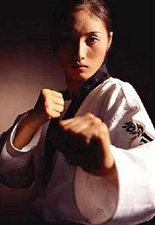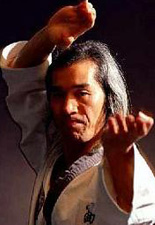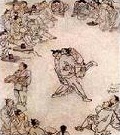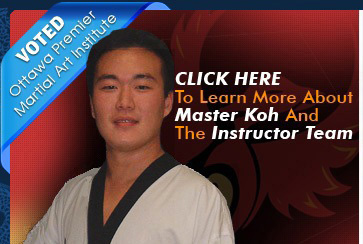What Is Martial Arts
Taekwondo is an ancient Korean martial art. The name is loosely translated to "the way of the Hand and Foot." However, the true meaning of Taekwondo is much more than simply kicking and punching. Taekwondo is a martial art that combines physical conditioning with mental discipline to achieve balance in life.

Taekwondo is also an official Olympic sport. In 1973, the South Korean government recognized the World Taekwondo Federation (WTF) as the legitimate governing body of the sport. The four major components of Taekwondo are:
- Poomse (pattern) is a choreographed sequence of movements including kicks, blocks, and hand techniques performed with an imaginary opponent or opponents. Poomse is used to develop concentration, balance, precision, reflexes, power, speed and agility.
- Kyorugi (sparring) is the practical application of various techniques against an opponent. In this type of competition self-control, concentration, speed, power, skilled technique, precision, knowledge and confidence are the major factors which contribute to a top competitor. Respect for yourself and your opponent is stressed in order to keep the sparring environment fun and safe for all people.
- Kyukpa (breaking) is performed in order to demonstrate the formidable power, precision, flexibility and great mental concentration of the Taekwondo practitioner.
- Ho Sin Sool (self-defense) is the study of learning how to defend oneself using pressure points, grappling, joint-locking techniques, throws and evasion tactics.
 People from all age groups and backgrounds will be rewarded through the practice of Taekwondo. Children develop concentration and confidence in taekwondo, which helps them excel in school. Teens experience a sense of pride and allows them to stand up for what is right, even when faced with conflicting morals, values, temptations, and peer pressures. Adults find that Taekwondo allows them to handle daily stress and feel years younger while advancing at their own pace.
People from all age groups and backgrounds will be rewarded through the practice of Taekwondo. Children develop concentration and confidence in taekwondo, which helps them excel in school. Teens experience a sense of pride and allows them to stand up for what is right, even when faced with conflicting morals, values, temptations, and peer pressures. Adults find that Taekwondo allows them to handle daily stress and feel years younger while advancing at their own pace.
Everyone sets his or her own personal goals of achievement. The benefits of taekwondo include better health and increased self confidence. Taekwondo also provides students with a set of morals and values to live by.
If you are searching for a fun and exciting way to get into shape this year, then it's time you try the Phoenix Taekwondo program.
All our staff and instructors at Phoenix Taekwondo are committed to providing the highest quality instruction while creating a friendly and positive atmosphere to guide you through your training.
History of Taekwondo
The origins of Taekwondo in Korea can be traced back to the Koguryo dynasty, founded in 37 B.C. Through the study of ancient Korea and its history, It can be known that the Koguryo people started practicing the art between 3 A.D. and 427 A.D.
 Silla, a kingdom founded in the southeast part of Korea was famous for Hwa-Rong-Do a primitive form of Taekwondo. Hwa-Rong Do was made up of youths of noble families, devoted to cultivating mind and body in order to better serve Silla. Hwa-Rong-Do was based on the code of honor which includes loyalty to the nation, respect and obedience to one's parents, faithfulness to one's friends, courage in battle and avoidance of unnecessary violence and killing.
Silla, a kingdom founded in the southeast part of Korea was famous for Hwa-Rong-Do a primitive form of Taekwondo. Hwa-Rong Do was made up of youths of noble families, devoted to cultivating mind and body in order to better serve Silla. Hwa-Rong-Do was based on the code of honor which includes loyalty to the nation, respect and obedience to one's parents, faithfulness to one's friends, courage in battle and avoidance of unnecessary violence and killing.
After Japan conquered Korea in 1910, the Japanese forbade the practice of any martial arts, with the exception of a small group of privileged men who were allowed to practice Judo and Kum Do. Despite the penalty of death for practicing martial arts, Korean martial arts flourished underground. These martial arts became a key component in the Korean struggle for liberation.
After the Korean War (1950-1953), the Korean people began recovering the thought of self-reliance and the traditional folkloric games. Martial art experts began opening Taekwondo gymnasiums all over the country. Taekwondo was popularized among martial artists in the country and then dispatched about 2,000 Taekwondo masters to close to 200 countries. 
Taekwondo was named the national sport of Korea in 1971. The present Kukkiwon was founded in 1972 to be used as the headquarters as well as the site of various Taekwondo competitions. One year later, in 1973 the World Taekwondo Federation was established and that same year, the first World Taekwondo Championships was held.
In 1979, President of the World Taekwondo Federation [WTF] was elected chairman of the World Federation of Non-Olympic Sports. The WTF became an IOC-recognized sports federation in 1980, a demonstration sport in 1988 Olympic games and finally an official Olympic Sport at the Sydney 2000 Olympic Games.
Today there millions of students who practice Taekwondo in over 190 nations who are part of the World Taekwondo Federation (WTF) making it the largest martial arts organization in the world and amongst the largest sports organization in the world.


